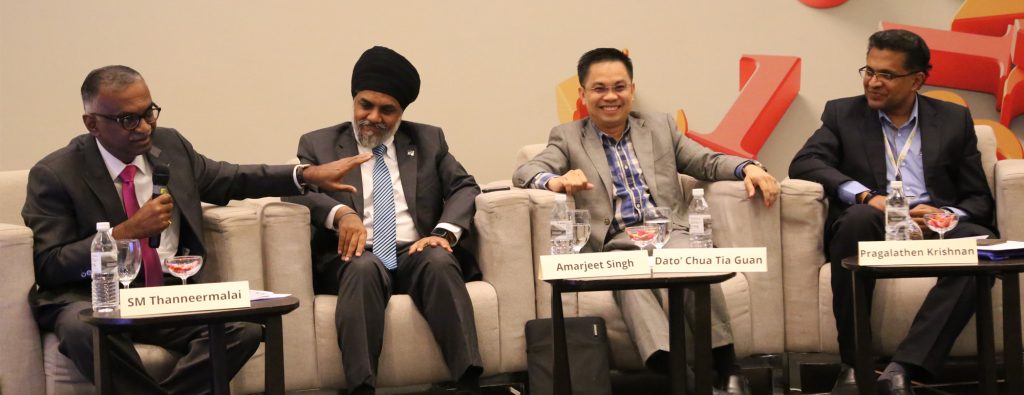
By Majella Gomes
The Malaysian Tax Reform Committee (TRC) was set up in September 2018, tasked with undertaking a comprehensive study on the Malaysian taxation system and to make recommendations on how it can be more efficient, neutral and progressive, in support of future economic growth and nation-building, explained SM Thanneermalai, Managing Director of Thannees Tax Consulting Services Sdn Bhd and Chairman of the Board of Trustees of the Malaysia Tax Research Foundation, Moderating and Panel Session at the recent MIA Budget 2019 seminar.
According to Tax Reform Committee member Dato’ Chua Tia Guan, the work of the Committee is primarily to find ways of reducing the tax gap, diversify sources of revenue, formulate taxation policies for the changing economic environments – particularly with the advent of the digital economy – and review the effectiveness of current tax incentives.
Tax Revenue Diversification. Sustainable tax revenues are imperative to reduce the current government deficit but closing the tax gap (compounded by the switch from GST to SST resulting in lower tax revenues) will not be easy.
Broadening the taxpayer base will be challenging. Currently, the tax base is narrow. Roughly 4.1 million families are still receiving BRIM payments, on which the government spends RM5 billion annually; this means that about eight million – out of a total population of about 30 million citizens – still need help. For social wellbeing, taxes have to be based on the ability to pay.
Strengthening Tax Compliance and Governance. Stripping away oil dividends of RM30 billion contributed by PETRONAS, the RM37 billion from the now-defunct GST and income tax refunds, what is left is the “real” Budget, said Chua.
To augment tax revenues, the Committee will be looking at all angles, especially stricter enforcement and compliance which alone could bring in as much as RM1 billion. “Under-declaration of taxes is bad for honest taxpayers,” he said, confirming that the TRC was now looking at a much wider field. The ongoing Special Taxation Voluntary Disclosure programme offering tax amnesty for errant taxpayers is one of the current measures to improve compliance and broaden the tax base.
Assessing Incentive Effectiveness. The Committee is also charged with analysing and formulating incentives and taxation to ensure Malaysia’s global competitiveness, and to optimise government spending on incentives.
Currently, Malaysia ranks 15th in the global list of places easiest to do business in, and offers 130 tax incentives through 34 coordinating agencies. However, Chua recommended doing a cost-benefit analysis to ensure that incentives are laser-focused to achieve our economic agenda, and to winnow out superfluous incentives and agencies. The TRC’s study so far shows that four out of five companies say they would have invested in Malaysia even if no incentives had been given so there is an argument for scaling back on these.
It is also important to constantly update incentives and policies to keep up with rivals in the internecine war for business and investment. For example, China has already started a programme of special incentives for companies that may be affected by its trade war with the US, noted Pragalathen Krishnan, Country Controller & Director, NXP Semiconductors Malaysia.
Trimming Corporate Tax Rates to Spur Business. The TRC is also looking at ways to bring down corporate tax rates to stimulate economic growth and competitiveness. Already, Malaysia is taking the cue from other markets by trimming public sector headcounts and government spending, which can support reduced corporate tax rates.
Amarjeet Singh, Malaysia Tax Leader & Business Tax Services Leader, EY, said the UK example of cuts of 25%-30% in public spending and a civil service pay freeze in 2009/2010 enabled the government to bring down tax rates from 28%. Today, the UK corporation tax rate stands at 19%, and this might be further slashed to 15%.
While other factors in addition to attractive tax rates were also at play, between 2010 and 2015, the UK raked in higher FDIs than other countries like Germany, Spain and France, and recorded the highest GDP growth rate in Western Europe in 2015.
Leveraging Tax Policies to Draw FDI. While global FDI has declined by 18% overall, ASEAN FDI bucked the trend with Indonesia, Thailand, Vietnam, Laos, and Cambodia all recording steady growth in FDI. Globally, governments are experimenting with tax policies to entice FDI, and competition is internecine. “We need to do something to get a piece of that pie!” stressed Amarjeet, pointing out that even Malaysian companies were moving to Thailand because the cost of doing business domestically was escalating.
Besides looking at costs and ease of doing business, he suggested targeting three categories of investors to bring in FDI:
- Efficiency-seeking investors looking to manufacture more efficiently and cost-effectively;
- Market-seeking investors wanting to sell to Malaysia and other countries in the region; and
- Resource-seeking investors wanting to buy resources like electricity to increase their capacity.
Amarjeet concluded that efforts should be made to attract all investors, not just foreign investors, and recommended incentives particularly to lure efficiency-seeking investors.








